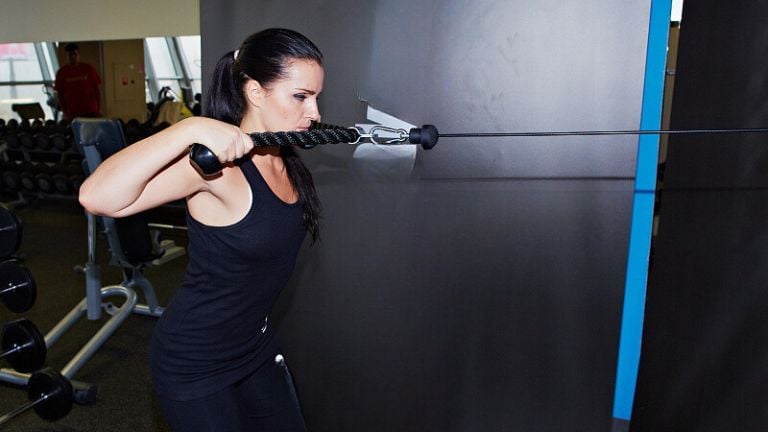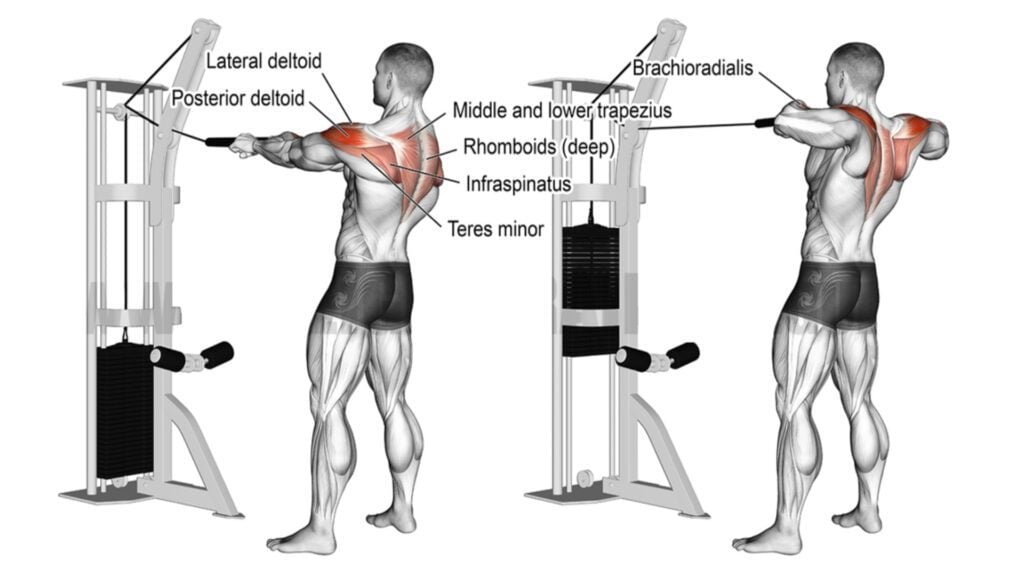Rear Delt Cable Pull also known as rear delt row primarily targets the posterior deltoids of the shoulder, which are often neglected by other shoulder exercises. You use a cable pulley machine to pull the weight straight toward your forehead.
Exercising the rear delts will prevent muscular imbalance and build overall shoulder strength. This exercise isn’t hard to do as long as you pay attention to your form.
You can use rear delt high cable pull as part of an upper body strength training regimen.

Standing Cable Rear Delt Pull
The standing cable rear delt pull with rope is a very effective and functional exercise for building muscle and strength in the rear deltoids.
The standing cable rear delt pull primarily targets the posterior deltoids. This movement also hits the traps, rhomboids, and biceps. It is usually performed for moderate to high reps, at least 8-12 reps per set, as part of an upper-body or shoulder-focused workout.
And by using cables, you’re keeping tension on the rear delts which is very beneficial for maximizing muscle hypertrophy.

Cable Rear Delt Row Muscles Worked
The Cable Rear Delt Row primarily targets the posterior deltoid (or rear deltoid), but it also engages several other muscles to assist with the movement and stabilize the body.
In addition to the rear delts, the cable rear delt row also works the following muscles:
- Rhomboids: these muscles retract the scapulae during the rowing motion.
- Trapezius: These muscles play a key role in retracting and depressing the scapulae.
- Infraspinatus and Teres Minor: Both are part of the rotator cuff group, and they aid in external rotation of the shoulder and stabilize the shoulder joint during the rowing motion.
- Brachialis and Brachioradialis:they act as stabilizers during the pulling motion.
- Latissimus Dorsi (Lats): they are still involved in the pulling motion, especially if the elbow travels slightly behind the body.
- Biceps Brachii: Acts as an elbow flexor and assists in the rowing motion.
- Erector Spinae: This group of muscles runs along the spine and helps maintain an upright and neutral spine position throughout the movement.
- Rectus Abdominis and Obliques: Engaged to stabilize the core and provide balance.
How To Do Rear Delt Cable Pull
- Attach a double-grip rope to a cable pulley about mid-chest level.
- Grasp one end of the rope in each hand and step backward until the rope is pulled taut and your arms and shoulders are stretched forward.
- Keep your lower back upright and slide your hips back so that your knees are slightly bent.
- Keeping your elbows out to the sides, exhale as you pull the rope towards your shoulders until your elbows travel passed your back.
- Slowly return the rope to the starting position.

Tips
- Retract your shoulder blades to keep your rear delts engaged during the exercise.
- Pull the rope outward during the positive portion of the rep, so your elbows are flared out, which will really stimulate the rear deltoids.
- Maintaining the right posture while working out is extremely important.
Modifications and Variations
This exercise can be done in a few different ways to make it more accessible or to target your muscles in new ways.
You can use a high cable or even a medium cable, provided you adjust the angle of your body so that your elbows and the angle of the cable are perpendicular to your torso.
1. Kneeling Rear Delt Rope Pull
Kneeling Rear Delt Rope Pull is a tremendous exercise that effectively works many muscles, including the shoulder, back, wing, and trapezius muscles.
Using Kneeling rear delt high rope pull gives people with shoulder issues an exercise to get the benefits of rows. In addition, face pull is one of the most effective corrective exercises that help compensate for poor posture and shoulder dysfunction.

How To Do
- Set the cable up at a high point with the rope attachments
- Grab the rope with both hands using an overhand grip, then take a step back and get onto knees facing the cable machine
- Starting with your arms stretched out and away, pull back through your elbows until your hands are just in front of your shoulders
- Slowly return to the starting position. Repeat for desired reps.
Tips
- Don’t lean backwards to pull the weight towards you.
- Focus on the mind-muscle connection to pull down by using your back muscles.
2. Face Pull
Face pull is a cable machine exercise that primarily targets the rear deltoid and to a lesser degree also targets the biceps, triceps, and traps. Use a cable pulley machine to pull the weight straight toward your forehead.
This exercise prevents muscular imbalance and builds overall shoulder strength.
Do not confuse the standing cable rear delt row with the cable face pull. As you pull, ensure the elbows stay high, and the rope remains at eye level.
Ensure you set the cable at face height rather than at the top of the machine, as this may over recruit the lats and negate some scapular upward rotation benefits.

How To Do
- Grab the ends of the rope attachment using a neutral grip (palms facing each other) and slightly lean back.
- Pull the rope toward your face as you spread the ends of the rope, so they end up on the sides of your ears just above your shoulders in the finish position.
- Hold this position for as a second as you squeeze your shoulder blades together, contracting rear delts.
- Then slowly return the rope to the start position and repeat for reps.
Tips
- Stand straight with feet in a comfortable balanced stance.
- Be sure to exhale when pulling weight toward your face.
- Think about trying to pinch your shoulder blades as tight as possible when pulling weight toward your face.
- Your upper arms should be straight out to your sides with elbows bent.
Related Posts
- Rear Delt Fly: Muscle Worked, Benefits, Alternate
- Dumbbell Posterior deltoid exercises for Bigger Shoulder
- 25 Best Rear Delt Exercises for Mass and Strength
- Bent Over Lateral Raise: Muscle Worked, Benefits, Alternate
- 28 Best Rhomboid Exercises for Strength and Muscle
- 12 Best Back Exercises and Workout for Mass & Strength
References
- Krzysztofik M, Wilk M, Wojdała G, Gołaś A. Maximizing Muscle Hypertrophy: A Systematic Review of Advanced Resistance Training Techniques and Methods. Int J Environ Res Public Health. 2019;16(24):4897. Published 2019 Dec 4. doi:10.3390/ijerph16244897
9 Best Cable Shoulder Exercises to Build Mass and Strength

Manish brings over 10 years of hands-on experience in weight lifting and fat loss to fitness coaching. He specializes in gym-based training and has a lot of knowledge about exercise, lifting technique, biomechanics, and more.
Through “Fit Life Regime,” he generously shares the insights he’s gained over a decade in the field. His goal is to equip others with the knowledge to start their own fitness journey.
